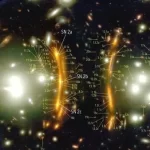Key Takeaways:
- A mysterious ‘Cold Spot’ in the cosmic microwave background radiation hints at a potential multiverse.
- Discovered in 1964, the CMB revolutionized cosmology, leading to an unexpected revelation.
- The Cold Spot, once thought a supervoid, may indicate collision with another bubble universe.
- Three main multiverse theories exist, including the controversial ‘many worlds’ interpretation.
- Stephen Hawking’s final paper proposes a finite, testable universe, challenging existing notions.
In 1964, Arno Penzias and Robert Wilson stumbled upon a persistent cosmic microwave background radiation (CMB) during radio astronomy experiments. This CMB, remnant heat from the Big Bang, became pivotal in understanding the universe. However, a peculiar anomaly emerged: the Cold Spot, a region in Eridanus colder than its surroundings, puzzled scientists.
Initially deemed a supervoid, recent research suggests an astonishing explanation. Durham Professor Tom Shanks proposed that the Cold Spot resulted from a collision between our universe and another bubble universe. This radical hypothesis potentially substantiates the existence of a multiverse, an idea once confined to the realm of science fiction.
To delve deeper, we must explore the three leading multiverse theories. The Copenhagen Interpretation, developed in the 1920s, suggests that particles exist in multiple states until observed, a notion criticized for its lack of clarity. Erwin Schrödinger’s Schrödinger’s Cat experiment highlighted its flaws.
Another approach, the “many worlds” interpretation by Hugh Everett in 1957, posits that every possible quantum outcome materializes in separate universes. Although initially controversial, this theory challenges the Copenhagen Interpretation’s limitations.
In a surprising turn, Stephen Hawking’s final research paper, co-authored with Thomas Hertog, revolutionizes the multiverse concept. Building on Inflation Theory, which proposes the universe expanded before the Big Bang, they suggest a finite, testable universe, debunking the notion of an infinite multiverse.
The implications are profound. If these theories hold, parallel universes may coexist, each with its own set of physical laws and realities. This groundbreaking revelation redefines our understanding of the cosmos, pushing the boundaries of human knowledge and imagination.

The history of our universe provides essential context. In its early days, the universe was a hot, dense plasma filled with nuclei, electrons, and photons that scattered light. Approximately 380,000 years after the Big Bang, the universe cooled below 3000 degrees K. Electrons combined with nuclei to form neutral atoms, allowing light to fill the darkness. This transformation, detected as cosmic microwave background radiation, verified the Big Bang theory.
Over eons, the universe continued to expand, gradually cooling to a temperature of around 2.7 K. However, temperature variations emerged due to uneven matter distribution caused by quantum density fluctuations after the Big Bang. The Cold Spot, located in the Eridanus constellation, is one such anomaly, about 0.00015 degrees colder than its surroundings.
Initially considered a supervoid, the Cold Spot’s true nature eluded scientists until 2017 when researchers from Durham University proposed a startling alternative. Professor Tom Shanks suggested that the Cold Spot resulted from a collision between our universe and another bubble universe, marking it as potential evidence for the existence of a multiverse.
To explore the multiverse concept further, three primary theories emerge. The Copenhagen Interpretation, originating in the 1920s, posits that particles exist in multiple states until observed, but this theory has faced criticism for its vagueness and reliance on observation.
Hugh Everett’s “many worlds” interpretation, introduced in 1957, presents a more radical idea. It suggests that every conceivable quantum outcome manifests in separate universes, challenging the limitations of the Copenhagen Interpretation. Although initially met with skepticism, this theory provides an intriguing perspective on the multiverse.
Stephen Hawking’s final research paper, published shortly before his death, marks another significant development. Collaborating with Thomas Hertog, Hawking proposed an alternative to the widely accepted Inflation Theory. This theory suggests that the universe expanded exponentially before the Big Bang. However, due to quantum nature, inflation would have ended at different times in different locations, leading to regions where inflation ceased, and a Big Bang occurred. These regions would be separated by expanding space and unable to interact.
Hawking and Hertog’s theory introduces a finite, testable universe, challenging the prevailing notion of an infinite multiverse. Their concept employs holography, reducing eternal inflation to a timeless state, thus simplifying the structure of the multiverse.
This revelation has profound implications, potentially reshaping our understanding of reality. If these theories hold, a multitude of universes may exist, each governed by its own unique laws of physics and inhabited by countless possibilities. The multiverse concept transcends science fiction, opening a new frontier of exploration and discovery.
As we contemplate the Cold Spot’s enigmatic chill and the theories it has inspired, we embark on a journey to redefine our place in the cosmos. The multiverse may hold the key to answering age-old questions about the nature of existence, the fabric of reality, and the infinite possibilities that await discovery. In a universe teeming with mysteries, the pursuit of understanding continues, and the Cold Spot may be the portal to an uncharted realm of knowledge.


